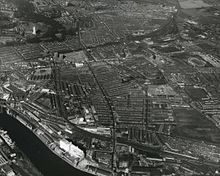Byker
[2] Possibly the earliest form of the visible evidence of development in Byker was by the Roman Emperor, Hadrian.
A wall, turrets and mile castles, stretching from the east to the west coast provided a barrier to invading border clans and tribes.
The area was populated by soldiers and their suppliers of foods, livestock and trades, such as weavers, saddlers and blacksmiths amongst others.
[4] In 1549 the Mayor and Burgesses of Newcastle sought to extend the borough's boundaries to include part of Byker Township, to take advantage of the land by the river ‘for the dropping of ballast for the coal trade’.
[12] The development was run as a "rolling programme" so local people could continue living in the area during the building work.
the outstanding success[13][citation needed] of Byker was as much to do with this as its innovative[vague] architecture which used a Functionalist Romantic style, differentiating the Estate from the Brutalist approach which was more common at the time.
[14] New leisure and shopping facilities have been brought to the Shields Road area, while community led initiatives have encouraged the growth of local enterprise and enriched the social fabric of the estate.
[18] Most of these facilities are in the bordering ward of South Heaton such as the East End Pool and Library on Corbridge Street.
[19] The ward itself is at Garden City standards in terms of housing density, offering a number of well-maintained green open spaces.
The ward hosts the 'Byker in Bloom' gardening competition which takes place every summer, and incorporates a number of different categories including 'Best Balcony' and 'Best Newcomer'.
[23][24] A quarter of people in the Byker ward have a long-term health problem or disability which affects day-to-day activities (25.0%).



